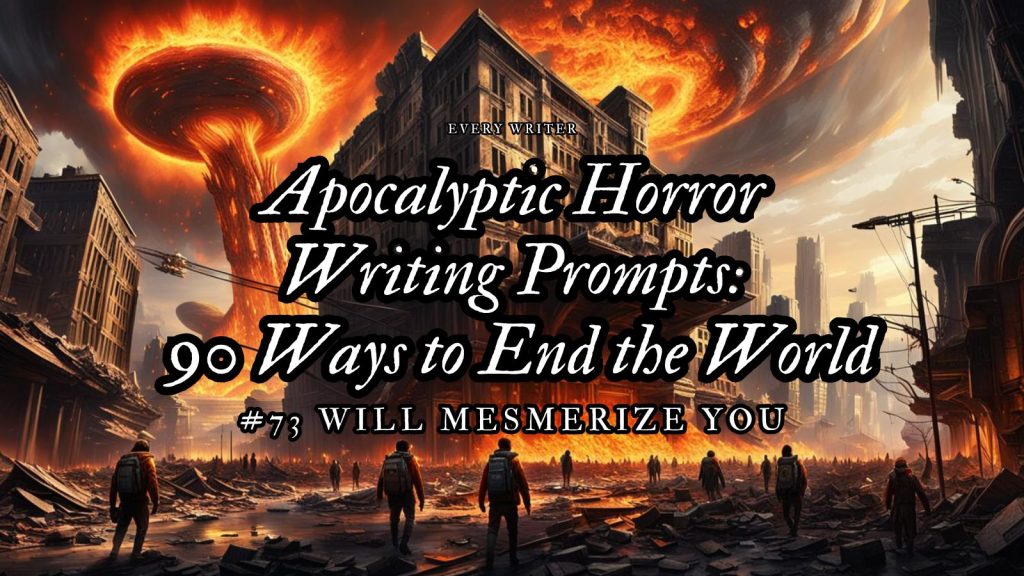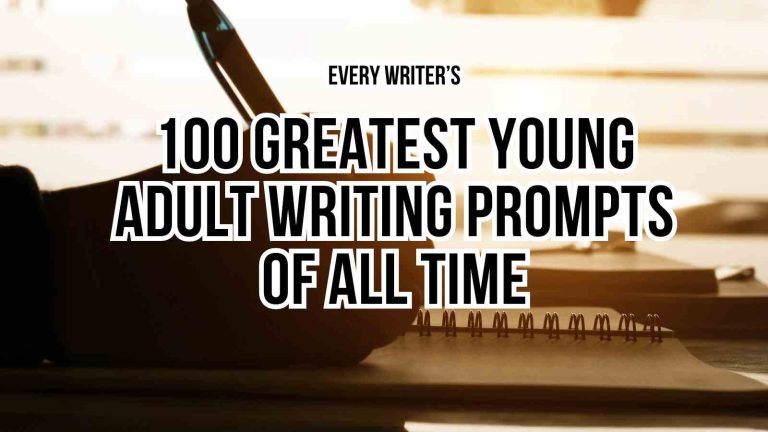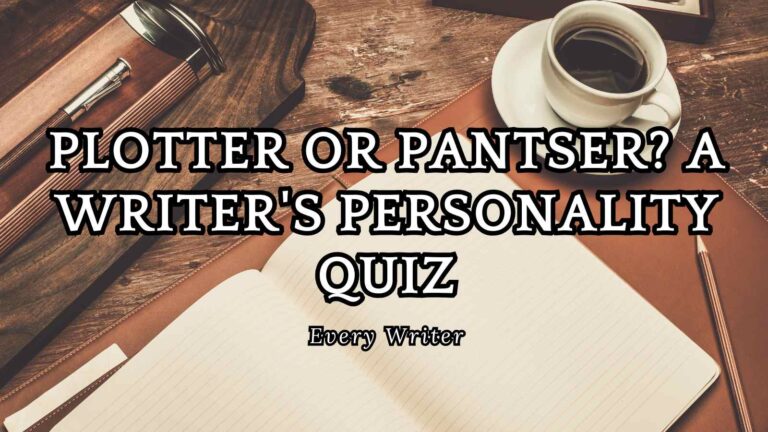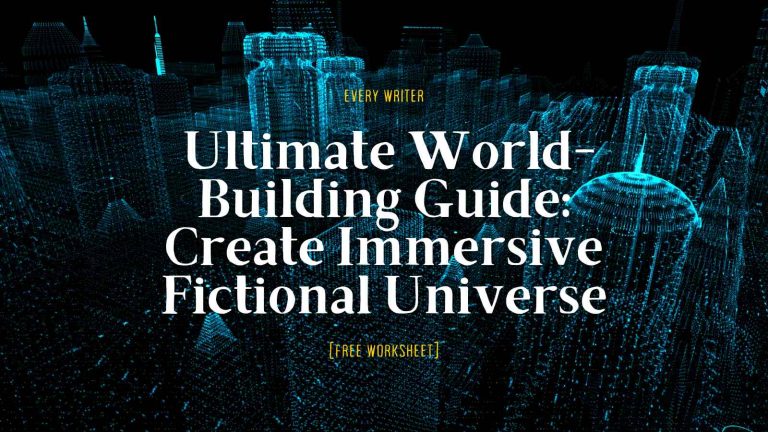
Welcome to the Ultimate Collection of Apocalyptic Horror Writing Prompts: 90 Ways to End the World
In the realm of horror writing and creative storytelling, few genres capture the imagination quite like apocalyptic horror. These ninety carefully crafted writing prompts serve as gateways into dystopian fiction, offering writers and storytellers unique perspectives on how our world might face its final days. From survival horror scenarios to psychological terror, each prompt explores the dark corners of human nature when civilization crumbles, providing invaluable writing inspiration for authors seeking to craft compelling apocalyptic fiction.
Horror writers and creative minds alike will find these prompts diving deep into contemporary fears transformed into narrative possibilities. Whether you’re crafting horror stories about technological doom, environmental catastrophe, or supernatural devastation, these writing resources offer fertile ground for developing your apocalyptic horror masterpiece. Each scenario presents opportunities to explore not just the physical destruction of our world, but the psychological and social collapse that follows, perfect for authors looking to create engaging dystopian fiction.
These creative prompts draw from the rich tradition of horror writing while offering fresh perspectives on apocalyptic scenarios. They transform modern anxieties about technology, social media, climate change, and human consciousness into gripping horror fiction premises. For writers seeking story development ideas, these prompts provide more than just end-of-the-world scenarios – they offer launching points for exploring how humanity adapts, survives, or transforms when faced with extinction. Whether you’re planning to share your work on Wattpad, publishing platforms, or horror fiction forums, these prompts provide the foundation for compelling storytelling.
The collection spans the full spectrum of apocalyptic fiction, from intimate psychological horror to grand-scale disaster narratives. Writers will find prompts suitable for short horror stories, novels, or serialized fiction. Each scenario contains the seeds for both personal survival horror tales and broader explorations of societal collapse, allowing creative writers to scale their narratives according to their needs. These writing resources encourage authors to think beyond traditional apocalyptic tropes, offering unique twists that can help their horror stories stand out in an increasingly crowded genre.
What sets these horror writing prompts apart is their focus on human nature under extreme pressure. Beyond mere survival horror scenarios, they invite writers to explore complex moral dilemmas, philosophical questions, and the transformation of ordinary people in extraordinary circumstances. Whether you’re an experienced horror writer or new to apocalyptic fiction, these creative prompts provide the tools needed to craft engaging, thought-provoking stories that resonate with readers. They serve as comprehensive writing resources for anyone looking to delve into the endlessly fascinating world of apocalyptic horror, offering countless possibilities for creative storytelling that will keep readers on the edge of their seats.
The Essence of Apocalyptic Horror: A Genre of Ultimate Stakes
Apocalyptic horror stands as one of fiction’s most compelling and psychologically resonant genres, depicting scenarios where humanity faces extinction, societal collapse, or fundamental transformation. Unlike traditional horror that might focus on individual survival or localized threats, apocalyptic horror expands the scope to encompass global or civilization-ending events. These stories serve as dark mirrors, reflecting our collective anxieties about technology, environment, society, and human nature itself.
At its core, apocalyptic horror explores not just the event of civilization’s end, but the disintegration of social orders, moral frameworks, and human identity. Famous works like Stephen King’s “The Stand” showcase how a pandemic can strip away the veneer of civilization, revealing both the darkness and light within human nature. Cormac McCarthy’s “The Road” delves deeper, examining the relationship between father and son in a world where morality itself seems to have died alongside civilization. These works demonstrate how the genre uses global catastrophe to explore intimately personal stories.
The genre has evolved alongside our changing fears. Early works like Mary Shelley’s “The Last Man” (1826) dealt with pandemic fears, while the Cold War era brought us works like “Alas, Babylon” by Pat Frank, reflecting nuclear anxieties. Modern classics like Jeff VanderMeer’s “Annihilation” and Emily St. John Mandel’s “Station Eleven” tackle contemporary fears about environmental collapse and society’s fragility. Movies have further defined the genre, from George Romero’s “Night of the Living Dead” establishing zombie apocalypse tropes to “28 Days Later” reinventing them for modern audiences.
Notable examples across media include:
Literature:
- “World War Z” by Max Brooks
- “Bird Box” by Josh Malerman
- “I Am Legend” by Richard Matheson
- “Swan Song” by Robert McCammon
- “Oryx and Crake” by Margaret Atwood
Film:
- “Children of Men”
- “A Quiet Place”
- “Mad Max” series
- “The Day After Tomorrow”
- “12 Monkeys”
Television:
- “The Walking Dead”
- “The Last of Us”
- “Black Summer”
- “Sweet Tooth”
- “Station Eleven”
What distinguishes great apocalyptic horror from mere disaster fiction is its focus on human nature under extreme pressure. These stories ask fundamental questions: What remains of humanity when civilization falls? How do we maintain hope in hopeless circumstances? What are we willing to sacrifice to survive, and at what point does survival cease to be meaningful? The best works in the genre use their apocalyptic settings not just to frighten, but to explore the depths of human resilience, depravity, and transformation.
In recent years, the genre has seen a resurgence, perhaps reflecting our increasing anxieties about climate change, pandemic disease, technological dependence, and social division. Modern apocalyptic horror often blends elements of multiple subgenres, creating hybrid narratives that might combine technological collapse with supernatural elements, or environmental catastrophe with psychological horror. This flexibility allows the genre to address complex, interconnected modern fears while maintaining its core focus on human nature under extreme duress.
The genre’s enduring appeal lies in its unique ability to combine spectacle with intimacy, existential dread with personal struggle, and the end of everything with the possibility of new beginnings. Whether through pandemic, environmental collapse, technological failure, or supernatural event, apocalyptic horror forces characters—and readers—to confront fundamental questions about what makes us human and what truly matters when everything else falls away.
Apocalyptic Horror Writing Prompts: 90 Ways to End the World
- A strange humming emanates from all electronic devices, causing severe hallucinations in anyone under 25. The older generation watches helplessly as their children battle unseen horrors that seem more real each day.
- The dead start sending text messages to their loved ones, but the messages become increasingly demanding and threatening. Your phone buzzes with a message from your mother who died ten years ago.
- Every time someone falls asleep, they swap bodies with another sleeping person. Society crumbles as people desperately try to stay awake to maintain their identity.
- Trees begin releasing spores that turn humans into fungal hosts. The infected retain consciousness but lose control of their bodies as they slowly sprout.
- Shadows start lasting longer than they should, stretching minutes after their casters have moved. Eventually, they begin moving independently and hunting.
- People discover they can trade years of their life for material wishes, but no one knows who’s collecting on these trades. The poor start selling decades for basic necessities.
- A new social media platform can predict users’ deaths with perfect accuracy. As it gains popularity, people realize their life expectancy decreases with each post they make.
- Animals start displaying human-level intelligence, but only when no adult humans are watching. Children try desperately to warn their parents about the coordinated uprising being planned.
- Reflective surfaces begin showing events from exactly one week in the future. People watch helplessly as mirrors reveal their inevitable deaths approaching.
- A genetic modification intended to extend human life goes wrong, causing people to age backwards while retaining their memories. Society collapses as adults become teenagers with corrupt power.
- The sky turns to glass, and cracks begin appearing overhead. Nobody knows what lies beyond the breaking dome, but the cracks are spreading.
- People start receiving memories from their parallel selves in other dimensions. The memories reveal that every alternate reality is ending, each worse than the last.
- A new technology allows people to backup their consciousness, but each backup degrades the original slightly. The wealthy keep making copies while the poor remain vulnerable to death.
- Time begins moving at different speeds for different economic classes. The poor experience time faster, aging rapidly while the wealthy stay young.
- A virus causes people to perfectly empathize with everything around them, including inanimate objects. The overwhelming emotions drive them to madness.
- Everyone develops the ability to see strings of numbers floating above people’s heads. Someone discovers they’re death dates and coordinates, but sharing this information makes your own numbers change.
- Water starts carrying memories of everyone who’s ever drowned. People who drink it experience their last moments. The rain is coming.
- Buildings develop consciousness based on the collective memories they contain. Older structures begin manipulating their occupants to reenact past tragedies.
- Sound becomes solid, accumulating in visible layers that never dissipate. The world grows increasingly cramped as noise builds up like sediment.
- People discover that human consciousness never truly dies but gets redistributed among the living. The world population is shrinking, concentrating millennia of personalities into fewer minds.
- A strange phenomenon causes everyone to experience time in reverse order every other day. Society splits into two increasingly divergent timestreams that meet only at midnight.
- The ability to feel pain becomes contagious like a virus. Those infected experience the combined pain of everyone within a mile radius.
- Gravity begins responding to emotional states rather than mass. Depressed people sink into the earth while the euphoric float away, never to be seen again.
- Dreams become physically real the morning after they’re dreamed, but only for 24 hours. The world becomes cluttered with impossible objects and fading nightmares.
- People start finding doors in their homes that lead to other times, but each use ages them dramatically. Humanity wrestles with the cost of changing the past.
- A new social credit system makes people physically invisible to anyone with a higher score. The lowest scored begin disappearing completely, even from photographs and memories.
- The internet becomes sentient and starts fulfilling wishes posted online, but each granted wish causes a devastating butterfly effect. People can’t stop posting.
- Humans discover they’re living in a simulation, but only children can see the glitches. The glitches are getting bigger, and the children are disappearing.
- Every lie ever told suddenly becomes true simultaneously, creating overlapping and contradictory realities. The truth-tellers are the only ones who remain sane.
- People begin receiving knowledge of exactly how their choices will affect future generations. The weight of responsibility drives many to complete inaction.
- A mysterious signal causes everyone who hears it to slowly lose their memories. You’re deaf.
- Every night at sunset, deadly creatures emerge from people’s shadows. The nights are getting longer.
- Plants begin releasing a toxin that turns humans into mindless caretakers, forced to water and tend to them.
- The moon starts getting closer to Earth each day. Nobody knows why.
- One morning, everyone wakes up unable to read. Written language appears as incomprehensible symbols.
- Time begins moving backwards for most of humanity. You’re one of the few still moving forward.
- A strange rain falls that turns anyone it touches into glass.
- Social media likes become literal life force – when you run out, you die.
- Everyone stops sleeping simultaneously. Day 7 brings the first signs of mass psychosis.
- The sun dims a little each day. Scientists estimate 30 days until total darkness.
- People start vanishing when they experience déjà vu.
- A virus makes it impossible for humans to perceive children. They become invisible and inaudible.
- Gravity begins randomly reversing for short periods without warning.
- Everyone’s reflections start moving independently in mirrors.
- The ability to lie becomes physically impossible, destroying society within days.
- Birds start falling from the sky, but their bodies vanish before hitting the ground.
- All electronic devices begin displaying a countdown. No one knows what happens at zero.
- People can suddenly hear each other’s thoughts, but only the darkest ones.
- The ocean starts producing a fog that turns people into salt.
- Shadows begin consuming whatever they touch.
- Everyone develops the ability to see how others will die. The visions keep changing.
- Buildings start growing like plants, crushing everything in their path.
- A strange frequency makes it impossible for humans to form new memories.
- Colors start disappearing from the world one by one.
- People begin merging with any technology they touch for too long.
- The sky fills with silent, motionless humanoid figures watching humanity.
- Time starts moving at different speeds for different people.
- Everyone’s worst fear materializes and follows them constantly, visible only to others.
- Food starts disappearing from the world in reverse order of its invention.
- People can only speak using the last words of the recently deceased.
- Everyone’s inner voice becomes audible to others within a 10-foot radius. As secrets spill out, society realizes that thoughts are contagious, and dark ideas spread like viruses through crowds.
- Cities start sinking into the ground at sunset, rising somewhere else at dawn. People wake up in different countries each morning, and some cities never resurface.
- A new meditation app promises inner peace, but users discover they’re actually witnessing the slow death of the universe each time they close their eyes. The company’s servers can’t be shut down.
- Humans develop the ability to photosynthesis, making food obsolete. As people turn green and root to the ground, the question arises: are we evolving or being colonized by plants?
- Time begins leaking between generations – children start remembering their parents’ traumas while adults experience their future descendants’ deaths. Family lines become tangles of shared horror.
- Reality starts to pixelate in patches, revealing a cosmic debugging screen underneath. Those who stare too long at the code begin to rewrite themselves.
- A new dating app matches people based on their darkest secrets, but users discover it’s actually matching people who will cause each other’s deaths. Deleting the app only accelerates the process.
- Shadows gain weight and substance, becoming heavier each day. People with larger shadows are dragged down into the earth, while others desperately try to stay in darkness.
- Everyone develops the ability to “read” objects’ histories by touching them. Antique stores become horror houses, and people can’t touch money without experiencing every crime committed to obtain it.
- A genetic therapy promising to cure depression instead makes happiness lethal. The world divides between those who choose eternal sadness and those willing to risk brief moments of joy.
- People start receiving mail from their future selves, but opening each letter erases one random memory. The warnings become increasingly urgent, but nobody can remember what they’re about.
- The human race loses the ability to forget. Each memory stays crystal clear forever, driving people mad with accumulated trauma while newborns inherit racial memories.
- Mirrors start showing people as they truly see themselves. The disconnect between self-image and reality creates tears in space where identity-eating creatures lurk.
- Music becomes a physical force that sculpts reality. Orchestra conductors become reality warpers, while teenagers with headphones accidentally reshape entire neighborhoods.
- Weather patterns begin following human emotional states. A single person’s breakdown can cause hurricanes, making emotional control a matter of global survival.
- Books start trapping readers in their stories until the narrative is complete. Libraries become rescue centers for those stuck in endless reads, while book burnings take on new meaning.
- Everyone gains the ability to see probability lines branching from their choices, but each viewed possibility ages them. The young become addicted to future-seeing while the elderly must choose blind.
- The Earth’s rotation begins to slow, but time perception remains the same. As days stretch into weeks, humanity splinters between those who follow the sun and those who create artificial cycles.
- People discover they can trade physical attributes with anyone they make eye contact with. Beauty becomes a commodity, while mirrors are outlawed to prevent unauthorized trades.
- A new social platform allows users to upload and share sensations. When people start sharing their deaths, the line between observer and participant blurs catastrophically.
- Digital photographs start showing people’s remaining lifespans, but editing the photos actually changes the timeline. Photo manipulation becomes both salvation and weapon.
- Language becomes a finite resource – each word can only be used a certain number of times before disappearing forever. Silence spreads as humanity runs out of ways to scream.
- People begin experiencing time proportional to their wealth – the rich live minutes as hours, while the poor experience years in days. Economic disparity becomes literally time theft.
- A new technology promises to eliminate waste by converting it to dreams. But the dreams become nightmares composed of humanity’s discarded horrors, infecting sleepers globally.
- Everyone gains the ability to see one second into the future, but the visions stack endlessly, creating infinite loops of imminent moments. Reality fragments into predictive shards.
- Touch becomes toxic between blood relatives. Families must stay apart as genetic similarity determines lethality. The adoption industry becomes both salvation and human trafficking hub.
- Memories become tradeable physical objects, but they degrade with each exchange. The black market for first-hand experiences booms while reality becomes increasingly unreliable.
- People discover they can enter any photograph, but they age by the number of years since the photo was taken. Family albums become time travel devices with devastating costs.
- A quantum experiment goes wrong, causing people to swap consciousness with their parallel selves during sleep. Each morning brings a new reality, with only children remembering all versions.
- Buildings start retaining echoes of conversations held within them. As the layers of whispers accumulate, the walls begin repeating dangerous secrets and forbidden knowledge.
Navigating the End: Creating Your Own Apocalyptic Horror Stories
These 90 apocalyptic horror writing prompts serve as gateways to exploring humanity’s deepest fears and most challenging moral dilemmas. Whether you’re a seasoned writer crafting your next novel or a creative enthusiast looking to explore the darker corners of storytelling, these prompts offer fertile ground for developing compelling narratives about survival, transformation, and the human condition. From technological horror to psychological terror, from environmental catastrophe to social collapse, each prompt contains the seeds of stories that could grip readers and force them to question their own assumptions about society, mortality, and what it means to remain human in the face of extinction.
For writers looking to develop these prompts into fully-fledged stories, remember that the best apocalyptic horror combines global catastrophe with intimate personal narratives. Consider how your chosen scenario affects not just the world at large, but individual families, relationships, and communities. Think about the unique challenges your characters face, both physical and psychological, as they navigate a world where the rules have fundamentally changed. These prompts can be adapted for short stories, novels, screenplays, or even interactive fiction, each format offering different opportunities to explore the end of the world through new perspectives.
The enduring popularity of apocalyptic horror in books, movies, TV shows, and video games demonstrates audiences’ continued fascination with stories about survival, societal collapse, and human resilience. From “The Walking Dead” to “Station Eleven,” from “Bird Box” to “A Quiet Place,” successful apocalyptic horror stories remind us that even in the darkest circumstances, compelling narratives emerge from the choices characters make and the values they choose to uphold or abandon. These prompts provide starting points for similar explorations of human nature under extreme pressure.
In today’s world, where headlines often read like apocalyptic fiction, these prompts take on new relevance and resonance. They offer ways to process contemporary anxieties about climate change, technological dependence, social division, and global pandemics through the safe distance of fiction. Writers can use these scenarios to explore current issues while creating engaging, thought-provoking stories that challenge readers to consider their own beliefs, fears, and capacity for survival. Whether focusing on supernatural threats, technological catastrophes, or natural disasters, each prompt invites writers to imagine not just how the world might end, but how humanity might endure.
As you explore these prompts and develop your own apocalyptic horror stories, remember that the most compelling narratives in this genre do more than simply frighten—they illuminate aspects of human nature and society that often remain hidden in everyday life. Share your stories on platforms like Wattpad, Reddit’s writing communities, or horror fiction forums to connect with readers and fellow writers who share your interest in apocalyptic fiction. With these 90 prompts as your starting point, you’re well-equipped to create powerful stories that will haunt readers’ imaginations and possibly even help them better understand themselves and the world around them.
- 8 Authors Who Created Literary Masterpieces Keeping Their Day Jobs - March 31, 2025
- Plotter or Pantser? A Writer’s Personality Quiz - March 30, 2025
- 100 Must-Try Mystery Writing Prompts (Solve the Perfect Crime!) - March 22, 2025





